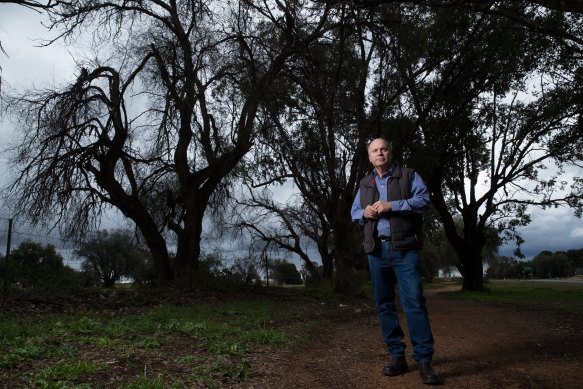By Ben Cubby
A cocktail of dangerous chemicals, including a banned pesticide “extremely toxic to humans”, has been found in air samples on public land in the state’s central west.
NSW Environment Protection Authority testing detected a toxic stew of agricultural chemicals on public roads west of Narromine following dozens of complaints from farmers that pesticides were drifting across the landscape, killing trees and crops.

Narromine farmer Bruce Maynard is alarmed by tests showing potentially toxic agricultural chemicals in the air.Credit: Janie Barrett
Among the chemicals found was dinitro-ortho-cresol, or DNOC, which has never been approved for use in Australia and was banned in the United States in 1991 due to damaging effects on human health and the environment.
Other agricultural chemicals found in EPA tests near Narromine, such as atrazine and diuron, are widely used as weedkillers on farms but should not be detected in public areas.
“It’s clear that we’re being exposed to cocktails of various chemicals,” said Bruce Maynard, a fourth-generation farmer who operates a mixed cropping and grazing property west of Narromine.
“What concerns me is that everyone’s exposure is not equal – children and those in compromised health situations are most at risk,” he said. “We need to address any human health impacts first of all.
“But it’s also the collapse of the environment out here. Trees that are hundreds of years old are failing in front of us. Tens of thousands of trees are affected.”
Internal government documents show that defoliation of some trees in the region west of Dubbo – around the townships of Narromine, Trangie, Warren, Gin Gin and Bundemar – is unlikely to have been caused by drought and tended to occur after cotton farms in the region sprayed their crops.
The EPA testing process detected only the presence of potentially dangerous agricultural chemicals in the air, not the quantity, so estimating any effects on human health is impossible at this stage.
“The presence of pesticides in the natural environment does not necessarily mean there is a risk to the environment or human health,” an EPA spokesperson said.
But the discovery of DNOC has baffled authorities because it has never been licensed for use.
“DNOC was not found consistently in all samples collected and there is no evidence to suggest it was used for spraying,” the spokesperson said. “Any detection of unlawful chemicals is concerning, but it can be challenging to pinpoint the source.
“In the case of the DNOC finds, we spoke to landholders in the area surrounding the monitoring equipment and found no evidence of its use or storage on these properties.”
The Australian Pesticides and Veterinary Medicines Authority (APVMA), the national agency responsible for approving agricultural chemicals, said DNOC had been banned in Europe due to potential health hazards and would not be approved here.
“There are no APVMA records of registrations or approvals for DNOC as a pesticide in Australia,” a spokesperson said. “Due to its toxicological effects, the United States Environmental Protection Agency cancelled DNOC registration as a pesticide in 1991.”
There is no public record of precisely which agricultural chemicals are being used where in Australia. In terms of volume, about 63,000 tonnes of pesticides are used around the country each year, according to United Nations data – more than triple the amount used in 1990.

The University of Sydney’s Dr Nicholas Chartres said the cumulative effects of many different pesticides needed to be taken into account.Credit: Nick Moir
“It is concerning that banned pesticide residues are being detected such as DNOC, which is known to damage the liver, kidney and nervous system in humans following acute exposure,” said University of Sydney Faculty of Medicine and Health senior research fellow Dr Nicholas Chartres.
“Of greater concern are the multiple pesticide residues being detected in these individual samples.
“The potential additive and cumulative effects of the nine-plus pesticides detected in some individual samples – such as one within a few kilometres of Trangie Central School – should be communicated to the local community, and the EPA must explain what action it will be taking to understand the levels of these exposures.
“To know that children may be breathing in air with this cocktail of pesticide residues is alarming.”
The EPA said it had issued 48 formal warnings, nine clean-up notices and 36 penalty notices for pesticide misuse since 2022, when the study near Narromine began. Now completed, the study data will be used to guide a broader pesticide monitoring program around the state.
Maynard said tests undertaken so far were inadequate and the community had unanswered questions.
“Clear detections have been made on public roads by the EPA,” he said.
“But in terms of detection levels, it could be extremely high or it could be marginal. We don’t know. Because people aren’t being informed in real-time, the community has no way to protect itself against exposure.”
The Morning Edition newsletter is our guide to the day’s most important and interesting stories, analysis and insights. Sign up here.